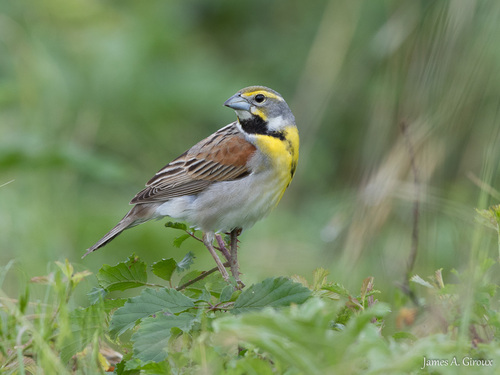
Dickcissel
The Dickcissel (Spiza americana) is a small, sparrow-like bird notable for its vibrant yellow throat and chest, contrasting with a black V-shaped marking on the breast. This migratory songbird plays a crucial role in grassland ecosystems, primarily consuming seeds and insects. While not holding major cultural significance, it is an indicator species, reflecting the health of prairie and agricultural habitats. It is named for its characteristic "dick-dick-cissel" call.
14-16 cm
Length
24.5-26 cm
Wingspan
Least Concern
Conservation Status
Distribution
Breeds primarily in the Midwestern United States, extending from the Great Plains eastward to the Appalachian foothills. Winters in southern Mexico, Central America, and northern South America (primarily Venezuela and Colombia). Migrates through the southeastern US and along the Gulf Coast.
Lifespan
Up to 5 years in the wild, though average lifespan is likely shorter due to predation and migration hazards.
Dickcissel's Habitat
Habitat Types
Grasslands, Prairies, Pastures, Agricultural fields (especially hayfields and fields with tall grasses)
Climate Zones
Temperate, Subtropical
Adaptations
Their preference for dense grasslands provides camouflage and ample food sources. Their strong legs and feet are adapted for perching on tall grass stems.
Variations
No recognized subspecies.
Appearance
Breeding Plumage
Breeding males have bright yellow throats and chests with a black V-shaped bib. Females and non-breeding males are duller, with streaked brown upperparts and buffy underparts. The yellow is much less pronounced.
Seasonal Feather Changes
Males molt into a duller non-breeding plumage after the breeding season, resembling females.
Sex Based Plumage Differences
Significant. Males are brightly colored during breeding season, while females are cryptically colored year-round.
Notable Features
Black V-shaped marking on the breast (in breeding males), Yellow throat and chest (brightest in breeding males), Rufous shoulder patches, Streaked brown back
Diet and Feeding
Primary Foods
Seeds, Insects, Grain
Foraging Behavior
Forages primarily on the ground, gleaning seeds and insects from low vegetation. Also perches on stems to feed on seed heads.
Specializations
No highly specialized feeding adaptations, but their conical bill is well-suited for cracking seeds.
Seasonal Diet Variations
Diet shifts depending on availability. During breeding season, insects form a larger part of the diet, providing protein for nestlings. In winter, relies more heavily on seeds and grains.
Behavior
Social Structure
Forms flocks during migration and winter. During breeding season, males are territorial, but often nest in loose colonies.
Communication
Distinctive "dick-dick-cissel" song, Various call notes, including a sharp "chip" and a buzzy flight call
Migration
Long-distance migrant, traveling between breeding grounds in North America and wintering grounds in Central and South America. Migrates in large flocks, often at night.
Territorial or Group Behaviors
Males defend territories during the breeding season, but territories may be small and clustered together. Outside of breeding season, they are highly gregarious.
Conservation
Threats
Habitat loss (conversion of grasslands to agriculture), Pesticide use, Collisions with structures during migration, Climate change (affecting habitat suitability)
Protection Programs
Conservation Reserve Program (CRP) in the US (encourages planting of grasses and forbs), Various grassland conservation initiatives
Local National Laws
Protected under the Migratory Bird Treaty Act in the US.
Population Trend
Overall, populations have declined significantly since the mid-20th century, although some regions show stability or slight increases.
Population Estimates
Estimated global population is 9 million, but with a wide confidence interval.
Interesting Facts
Dickcissels are known for their irruptive movements.
Their breeding distribution can vary dramatically from year to year, likely in response to changes in habitat conditions and food availability.
They are polygynous.
Males may mate with multiple females within a single breeding season.
They sometimes hybridize with Lark Buntings.
Though rare, hybridization has been documented where their ranges overlap.
Faqs about Dickcissel
Why are Dickcissel populations declining?
The primary reason is habitat loss due to the conversion of grasslands to intensive agriculture. Pesticide use also poses a threat.
Where can I see a Dickcissel?
During the breeding season, look for them in grasslands, prairies, and agricultural fields in the Midwestern US. During migration, they can be seen in a wider range of habitats.
What does a Dickcissel sound like?
The male's song is a distinctive "dick-dick-cissel," often repeated from a prominent perch.
Are Dickcissels endangered?
No. Dickcissels are classified as 'Least Concern' by the IUCN, but have experienced significant population declines.
Copyright @ Nature Style Limited. All Rights Reserved.
 English
English